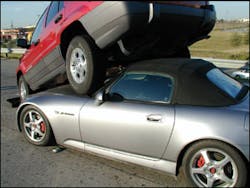Subject: NFPA 1670 Vehicle Rescue, Technician-level Skills and Competencies
Topic: Advanced Hands-on Training Skill: Electrical Shutdown, Roof-resting Vehicle
Objective: Given the scenario of a vehicle resting on its roof with an occupant trapped inside, crews must shutdown the vehicle’s electrical system.
Task: In this training scenario, the vehicle’s battery is located within the engine compartment. It must be accessed and both negative and positive cables must be disconnected or “double cut” while the vehicle is resting on its roof on a level surface.
This University of Extrication column is the fifth in a multi-part series presenting advanced technician-level vehicle-rescue training scenarios. This column describes a rescue challenge that meets the criteria of a technician-level skill and competency of NFPA Standard 1670.
This scenario is based on a incident where a sedan has rolled onto its roof. There is an occupant trapped inside the vehicle and extrication will be required. The vehicle’s electrical system must be shut down as a safety measure. Everyone agrees that electrical system shutdown is important at crash scenes. Few crews, however, ever train on shutting down the electrical systems of a roof-resting vehicle.
When a vehicle rolls onto its roof, the engine compartment typically comes into contact with the ground. If the battery is located within this area, it becomes very challenging to access it. When dealing with an upside-down vehicle, there are several options to access the battery. In every case, however, vehicle stabilization must be accomplished along with putting normal fire-safety and hazard-control measures in place. Once it is safe to work on and around the vehicle, crews can begin their battery-access and shutdown assignment.
One battery-access option, the side attack, involves removing a front fender and then accessing the battery by making an opening through the inner wheel well. Inspect the undercarriage of the vehicle first and determine which side of the engine compartment the battery is located on. You may be able to see the bottom of the battery, the battery cables or the bottom of the battery tray itself.
Once you know which side of the engine compartment you need to work on, move or remove the appropriate fender by attacking the spot welds or screws holding it in place. With practice, this is not a time-consuming task, but one that you should experience in training to work out the procedure. Using cutting or prying tools, the inner wheel well can then be opened to expose the battery and hopefully the negative and positive cables. With sufficient access, the cables can be disconnected or double cut.
Another access option, the frontal attack, involves attacking the engine compartment to reach the battery by going through the headlight assembly. With some vehicle designs, there may be a ready-made opening already waiting for you just behind the headlight lens. That opening might provide quick access to the battery itself. Forcibly take out the headlight lens and then attack the rear headlight housing. If an opening exists in the panel behind the headlight, the battery may be already visible. Work through this opening or enlarge it sufficiently to allow the cables to be worked with.
At a rollover, crews may also be able to use yet another method to access the battery, the undercarriage attack. It may be possible to locate the battery cables and work down through the undercarriage of the vehicle itself to cut them. Since the car is on its top, the undercarriage is exposed. Since the vehicle is generally engine-heavy, the front of the vehicle is usually at a convenient height to work. By doing a close inspection of the bottom of the engine compartment, it may be possible to see the battery cables or the bottom of the battery tray. Once you find the cables, figure out a way to move or remove things to get access to them. You’ll need enough cable to allow a cutting tool to sever both the negative and the hot wires. In real-world scenarios, electrical system shutdown has been accomplished quite frequently by this very method, working down through the bottom of the engine compartment.
In all cases when shutting down a vehicle’s electrical system, the negative cables should be either disconnected or “double cut” first. Then to complete the task, all positive or “hot” cables should be disconnected or “double cut.” Be alert to the very real possibility of multiple battery cables attached to each battery terminal or post. A vehicle today can easily have six separate cables: three ground and three positives. Get them all. If it is your agency’s policy to cut battery cables, each cable should be cut twice to remove a chunk of it. With a double cut, the fresh-cut ends cannot contact each other and re-establish a circuit.
TASK: Review the images provided of real-world rollover crashes. Understand the difficulty that can be anticipated when it is necessary to access the battery and shut down the vehicle’s electrical system.
Using an acquired vehicle, roll it onto its roof on a level surface. Complete roof-resting stabilization and hazard-control measures. The vehicle’s battery, located within the engine compartment, must then be accessed and both negative and positive cables must be disconnected or “double cut” while the vehicle is resting on its roof. Complete all three access evolutions: side wheel-well, frontal headlight and undercarriage access.
Ron Moore will present “University of Extrication” at Firehouse Expo 2005, July 26-31 in Baltimore.Ron Moore, a Firehouse® contributing editor, is a battalion chief and the training officer for the McKinney, TX, Fire Department. He also authors a monthly online article in the Firehouse.com “MembersZone” and serves as the Forum Moderator for the extrication section of the Firehouse.com website. Moore can be contacted directly at [email protected].





